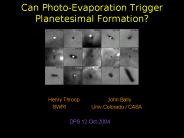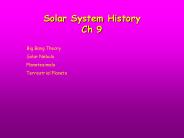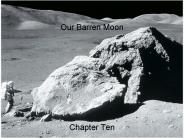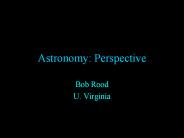Planetesimal PowerPoint PPT Presentations
All Time
Recommended
1-56 of 531
Advection-Diffusion Approx. Johnson, Goodman, & Menou (2006) Type I migration = advection. Turbulent random walk = diffusion. Treat using Fokker-Planck model ...
| PowerPoint PPT presentation | free to download
Initial toroidal magnetic flux is lost through ... Toroidal flux versus time. Volume averaged value saturates at ~ 3 - 4 x 10 ... primarily toroidal at all ...
| PowerPoint PPT presentation | free to view
OB associations like Orion are rare but large majority of star formation in ... In Orion, typical low-mass star age is 106 yr, but O star age is 104 yr disks ...
| PowerPoint PPT presentation | free to download
Graphics cards are a cheap and new parallel computing platform ... Typical travel distance in each timestep can be chosen to be small compared to Hill sphere. ...
| PowerPoint PPT presentation | free to download
Accretion and early history of planetesimals and planets: the noble ... cosmogenic. nucleogenic. radiogenic. fissiogenic. in-situ. primordial. exotic. normal ...
| PowerPoint PPT presentation | free to view
The Colliding Planetesimals Theory: The interaction of earth-orbiting and Sun ... The Ejected Ring Theory: A planetesimal the size of Mars struck the earth, ...
| PowerPoint PPT presentation | free to download
Planetesimal heating. 26Al as tool for radiometric dating: ... 26Al as planetesimal heat source: ... stronger heated planetesimals have earlier formed chondrule ...
| PowerPoint PPT presentation | free to download
Planet Formation in Protoplanetary Disks: Origin of Planetesimals A. G. Tevzadze Abastumani Astrophysical Observatory, Georgia Tbilisi State University, Georgia
| PowerPoint PPT presentation | free to download
Planetesimal Formation: Numerical Modeling of Particle Growth, Settling, and Collective Gas-Grain Interactions S. J. Weidenschilling, Planetary Science Institute
| PowerPoint PPT presentation | free to download
Planetesimals outside the snow line became eccentric ... Density of solids: divide mass of region by total N, or fix planetesimal mass at 0.01M ...
| PowerPoint PPT presentation | free to download
The planetesimal of outer solar system structure ... Almost homogeneous large planetesimals, inside which the original structure ...
| PowerPoint PPT presentation | free to download
Planetesimal: small body from which a planet originated in the development of the solar system. Some planetesimals fused together to form protoplanets. ...
| PowerPoint PPT presentation | free to view
Solar System History Ch 9 Big Bang Theory Solar Nebula Planetesimals Terrestrial Planets Big Bang Hypothesis 13-14 billion years ago, all matter and energy was ...
| PowerPoint PPT presentation | free to download
Accretion of Planets Bill Hartmann Star & Planet Formation Minicourse, U of T Astronomy Dept. Lecture 5 - Ed Thommes Overview Start with planetesimals: km-size bodies ...
| PowerPoint PPT presentation | free to download
EVOLUTION OF THE PLANETESIMAL SWARM. FORMATION & EARLY EVOLUTION OF PLANETARY SYSTEMS ... PLANETESIMAL DISK : ISOLATION MASS. A simple estimate: ...
| PowerPoint PPT presentation | free to view
planetesimals. industrial importance. building, mining, oil shale. physics ... ( 1982) while studying planetesimal collisions (rock impacts) V. t dev = 0.7 dev = 0.2 ...
| PowerPoint PPT presentation | free to view
planetesimals if parked so close early... Interiors of Hot Jupiters. DS (2003) w updates ... use the He settling for Saturn (Fortney & Hubbard 2003) ...
| PowerPoint PPT presentation | free to download
... solid particles became cemented into planetesimals (1 km or so in ... as the moon) form when a planetesimal is attracted by the gravitational pull of ...
| PowerPoint PPT presentation | free to view
The formation of stars and planets. Day 4, Topic 3: Agglomeration of particles ... Planetesimals agglomerate via gravitational interactions and form rocky planet ...
| PowerPoint PPT presentation | free to view
Wet Planetesimals. Supported by M. Drake and K. Righter. Water found ... The Wet Planetesimal Theory. Wet material at about 1 AU accretes together to form Earth ...
| PowerPoint PPT presentation | free to view
(Key term) Planetesimal: the tiny building blocks that make a planet ... 5. Smaller Planetesimal collide with the larger ones, and planets begin to grow ...
| PowerPoint PPT presentation | free to view
... from an accretion of stoney planetesimals, which themselves formed from the ... levels of radioactivity or a secondary collision with another large planetesimal. ...
| PowerPoint PPT presentation | free to view
Steward Observatory, The University of Arizona ... Dynamically hot outer planetesimal belts. Lack of interior planetesimal belts ...
| PowerPoint PPT presentation | free to view
The mare basalts solidified between 3.1 and 3.8 billion years ago ... The mare basins were created later by the impact of planetesimals and filled ...
| PowerPoint PPT presentation | free to download
Jupiter is to blame. Asteroids are fragmented planetesimals. Comets ' ... Comet Impacts on Earth. 94: comet hit Jupiter. Dinosaur extinction: comet or asteroid ...
| PowerPoint PPT presentation | free to view
icy planetesimals. from formation of the Jovian planets ... moon was probably created when a big planetesimal tore a chunk out of the newly forming Earth. ...
| PowerPoint PPT presentation | free to download
Planetesimal Accretion in. alpha Centauri. Philippe Th bault (Stockholm/Paris Observatories) ... dV evolution among planetesimals of different sizes, under the ...
| PowerPoint PPT presentation | free to view
Planetesimals in the early solar system collide and accrete to form protoplanets. ... Planetesimal: small ~1km rocky asteroid-like objects in early solar system ...
| PowerPoint PPT presentation | free to view
Prevention of planetesimal accretion beyond 50 AU due to MRI turbulence (Balbus et al. ... gravitational instability & planetesimal formation are possible ...
| PowerPoint PPT presentation | free to view
comets. Larger planetesimals attract smaller ones (gravity) ... comets collide with terrestrial planets. Deposit volatiles ... of comets (volatile ...
| PowerPoint PPT presentation | free to view
Jupiter/Saturn internal structure (JUNO,Cassini) Extra-solar planet atmospheric compositions ... ( close-in means less easy to scatter planetesimals) How do we ...
| PowerPoint PPT presentation | free to view
Capture: Mutual Collisions. Model: Sun, Jupiter, Saturn. 5000 planetesimals ... 1. Collisions only, 2x104 years, Jupiter & Saturn: fixed mass of 10 M ...
| PowerPoint PPT presentation | free to download
Trapping of planetesimals orbiting nearby the proto-Jupiter. Mass growth of the planet ... planetesimal disk which drove the planetary migration. So far we know: ...
| PowerPoint PPT presentation | free to download
... idea proposed that the planets formed from debris torn off the ... How did terrestrial planets form? ... Larger planetesimals and planets were able to form. ...
| PowerPoint PPT presentation | free to view
http://hubblesite.org/newscenter/archive/releases/star ... What is a planetesimal? What is the difference between a 'fast collision' and a 'slow collision' ...
| PowerPoint PPT presentation | free to view
TERPS Conference. Dec. 9, 2004. Background. Formation of Jupiter and Saturn in our Solar System. Gradual accumulation of planetesimals into cores followed by ...
| PowerPoint PPT presentation | free to download
Once the rocks solidify, radioactive decay will then take over. ... Over time, the planetesimals grow as more molecules condense out of the nebula ...
| PowerPoint PPT presentation | free to view
What was the general composition of the solar nebula? What are planetesimals? ... the stages of Solar System formation. I. Composition of Solar Nebula ...
| PowerPoint PPT presentation | free to view
... result of low-speed collisions, building up to small bodies called planetesimals. ... Maybe these planets formed beyond the frost-line, but due to friction ...
| PowerPoint PPT presentation | free to view
Giant planets ' composition: D/H, He/H, oxygen source ... Activity of outer small bodies and water content in outer planetesimals ...
| PowerPoint PPT presentation | free to download
Step 1 Accretion of planetesimals to form large Earth-like ... and poles do not rotate at same rate (oblate shape): 10 h 40 min and 10h 15 min respectively ...
| PowerPoint PPT presentation | free to view
Les collisions agissent TOUTES. les tapes d' volution des syst mes plan taires ... Syst me en sera profond ment affect . Accretion of planetesimal in the ...
| PowerPoint PPT presentation | free to download
The Moon and terrestrial planets were bombarded by planetesimals early in ... After formation, giant planet orbits were affected by gravitational nudges' from ...
| PowerPoint PPT presentation | free to view
NEBULAR HYPOTHESIS
| PowerPoint PPT presentation | free to download
In a dense molecular cloud far, far away proposed originally by Kant, Laplace, and others in the 1700's solar system formed from a nebula (cloud of interstellar gas ...
| PowerPoint PPT presentation | free to view
Origin of Our Solar System TEK Objective 5: Earth in space and time. The student understands the solar nebular accretionary disk model. The student is expected to ...
| PowerPoint PPT presentation | free to view
1) Dust settles on the disk's mid-plane and coagulates in pebbles ... Consistent with one basin on Vesta, lack of shock ages of meteorites prior to ...
| PowerPoint PPT presentation | free to download
Chapter 8 Formation of the Solar System
| PowerPoint PPT presentation | free to download
Initial Stages of Planet Formation in Protoplanetary Disks: Origin of Vortices A. G. Tevzadze Abastumani Astrophysical Observatory, Georgia Tbilisi State University ...
| PowerPoint PPT presentation | free to download
Chapter 8 Welcome to the Solar System
| PowerPoint PPT presentation | free to download
Formation of protostar and protostellar nebula. Evolution of early sequences and ... Protostar starts sucking in nearby nebular gases, forms local increase in ...
| PowerPoint PPT presentation | free to download
Title: PowerPoint Presentation Author: Robert Rood Created Date: 3/28/2004 11:13:21 PM Document presentation format: On-screen Show Other titles: Times New Roman ...
| PowerPoint PPT presentation | free to download
Chapter 5: Formation of Stars and Planets (and more) Part 2 - the Solar System EVERYTHING in the Solar System orbits the Sun! What is EVERYTHING?
| PowerPoint PPT presentation | free to view
Extrasolar Planets The first planet detected ... Rules of chemistry Observations of rock ... Asteroids Some asteroids appear to be rubble piles of broken ...
| PowerPoint PPT presentation | free to view
Earth, Moon and Mars: How They Work
| PowerPoint PPT presentation | free to download
Gravitational scattering of discrete bodies treated as stochastic events, allows ... Discrete bodies can be designated with specified masses and orbits (i.e., planets) ...
| PowerPoint PPT presentation | free to view
























































